
Biotechnology And Its Applications: Biotechnology refers to the industrial scale production of biopharmaceuticals and biologicals from genetically modified organisms (GMOs), which include microbes, fungi, plants and animals. In this field, DNA is extracted from organisms and combined with vectors to generate multiple copies. The modified DNA, which contains the desired genes, is then inserted into other organisms, causing the inserted DNA to express its characteristics. These advancements in biotechnology have opened up new applications in various industries, providing significant benefits to humanity
The introduction of genetic engineering in the 1970s transformed biotechnology, medicine, and biology research by allowing for the manipulation of organisms' genetic material. Scientists have made rapid progress in several fields, allowing them to modify DNA precisely. The article provides detailed notes on biotechnology and its applications for Class 12, aligned with the updated NEET syllabus , and aims to help students prepare effectively for their exams.
Also Check:
Biotechnology And Its Applications Overview
Biotechnology is the broad field of biology that uses technology and living things and their parts to develop, alter, and produce useful products for human use. An agricultural engineer named Karoly Ereky coined the term "biotechnology" in 1919, earning him the title "Father of Biotechnology." Biotechnology and Its Applications NCERT PDF is included below to provide a thorough understanding of this chapter in accordance with the updated NEET syllabus. Given the importance of this chapter in the NEET Exam, the new NCERT PDF on biotechnology and its applications is essential for all students who want to prepare for the NEET syllabus effectively.
To gain a better understanding, NEET Exam candidates should read the detailed notes on Biotechnology and Its Applications. Previous NEET exams included many questions from the NCERT notes on Biotechnology and Its Applications.
Biotechnology And Its Applications
Biotechnology is the process of combining natural sciences with living organisms, cellular components, and molecular counterparts to create innovative and beneficial products and services. It comprises three key research domains:
- Genetic modification of organisms to enhance their catalytic capabilities.
- Environmental conditions are optimized to promote microorganism growth and function.
- Implementation of downstream technologies to purify generated compounds.
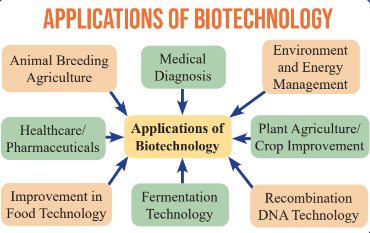
Biotechnological Applications in Agriculture
The application of biotechnology in agriculture also known as Green Biotechnology or the Green Revolution, has transformed farming practices worldwide. It aims to enhance the quality and quantity of food crops, addressing the increasing demand for agricultural products. Many strategies, such as crop-based agriculture based on genetic engineering, organic farming, and agrochemicals have contributed to this transition.
Norman Borlaug , a visionary leader, pioneered the Green Revolution, which began in the late 1960s. M.S. Swaminathan was key in promoting modern agricultural techniques and technologies throughout India. The primary goal of the Green Revolution was to boost agricultural productivity by increasing crop yields. This was accomplished through the widespread adoption of improved seed varieties, the development of irrigation infrastructure, and the effective application of agrochemicals.
However, challenges persist, particularly for farmers in developing countries who struggle to obtain and afford agrochemical inputs. Given the limitations of traditional breeding techniques in addressing yield constraints and pest management, incorporating biotechnology provides promising solutions to improve agricultural productivity and sustainability.
Tissue Culture in Plants
Plant tissue culture, also called micropropagation, is a method for growing plant cells, tissues, or organs in a clean environment using a special nutrient mixture. It has several benefits compared to traditional methods:
- Making exact copies of plants with desired traits.
- Growing mature plants quickly.
- Producing many plants in a small area.
- Growing plants without seeds or natural pollination.
- Regenerating plants from genetically modified cells.
- Growing plants in clean containers to avoid spreading diseases.
- Germinating seeds with a low chance of growing otherwise.
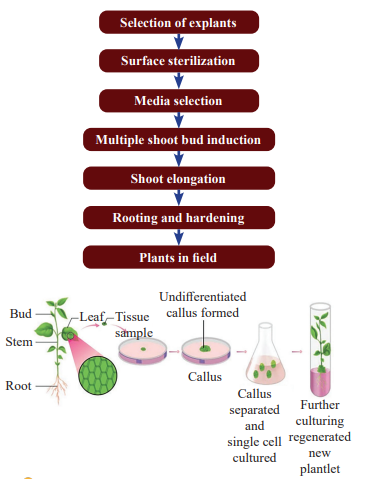
Micropropagation
Micropropagation is a tissue culture technique in which plants grow from small pieces of meristematic tissue. Meristem culture, on the other hand, uses apical meristems to generate plant clones through vegetative propagation. Micropropagation is the process of carefully selecting tiny fragments of plant tissue from a mother plant and nurturing them under controlled laboratory conditions in order to produce new plants.
Somaclones are plants produced through tissue culture with the same genetic identity as the parent plant from which they originated and were cultured. Meristem culture, a type of tissue culture technique, is used in laboratories to remove viruses and other pathogens from plants while being grown in vitro.
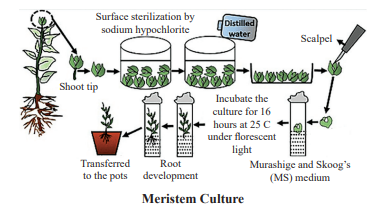
Somatic Hybridization
Somatic hybridization is combining protoplasts isolated from the somatic cells of two different plant species/cultivars to create hybrid plants.
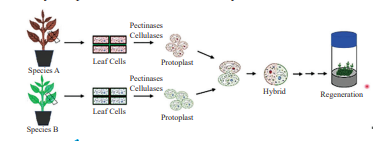
Genetically Modified Food
Genetically Modified Organisms (GMOs) are plants, animals, and microorganisms genetically modified using biotechnology. GMOs, particularly genetically modified plants and crops, offer numerous advantages that farmers worldwide recognize and embrace.
- Firstly, they exhibit increased resilience to various environmental stresses like cold, drought, salt, and heat, contributing to more robust agricultural systems.
- Additionally, GMOs diminish the dependence on chemical pesticides by incorporating traits that make them resistant to pests, promoting sustainable farming practices and reducing environmental pollution.
- Moreover, they are pivotal in minimizing post harvest losses, ensuring greater food security and economic stability. Furthermore, genetically modified plants optimize mineral utilization, enhancing soil fertility and prolonging agricultural productivity.
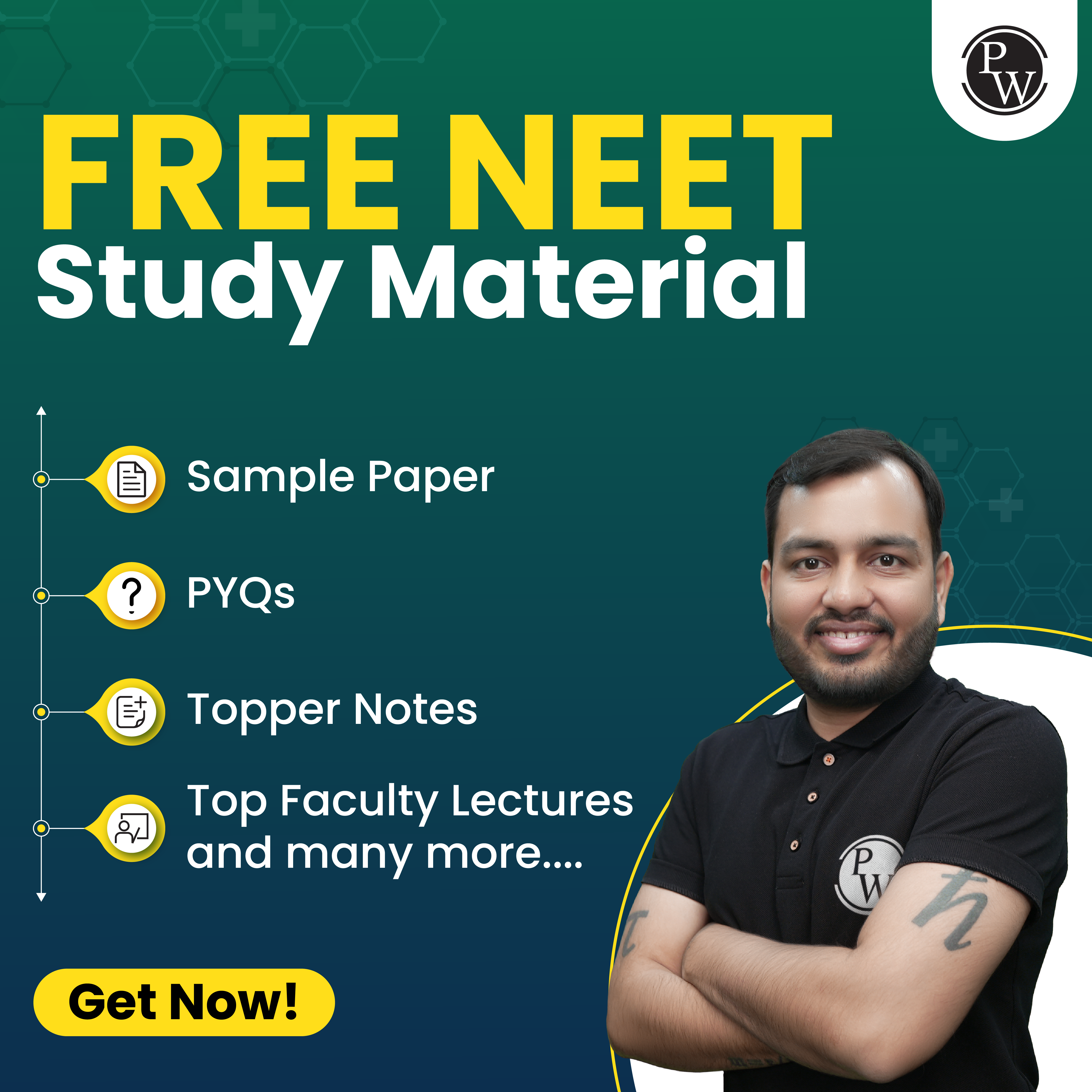
Golden rice, for example, is enriched with the Vitamin A precursor beta carotene, which addresses nutritional deficiencies while improving public health outcomes. Beyond agriculture, GMOs offer designed solutions for industrial applications, such as producing starches, fuels, and pharmaceuticals, further underscoring their versatile utility and potential societal impact. Through continuous research and innovation, GMOs promise to address global challenges and advance sustainable development goals.
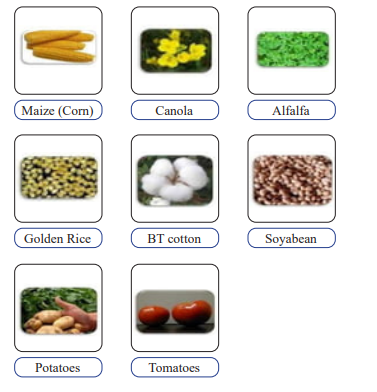
Insect Resistance- Bt traits
Bt toxin genes sourced from Bacillus thuringiensis were extracted and introduced into various crop plants, including cotton. These Bt toxins typically target specific groups of insects and are governed by genes known as cry genes. For instance, proteins produced by crylAc and ( cryllAb ) genes effectively combat cotton bollworms, while crylAb specifically targets corn borers.

BT Cotton
The Bt toxin, derived from the bacterium Bacillus thuringiensis (Bt), has been utilized to create genetically modified plants with built-in insect resistance, which means they can fend off pests without chemical pesticides. Bacillus thuringiensis produces proteins harmful to insect pests like beetles, caterpillars, and flies. These proteins are made into crystalline structures known as Bt toxins during specific stages of bacterial growth.
When insects consume these toxins, their alkaline gut environment activates them, causing them to bind to the surface of the insect's gut cells. This binding creates pores in the cell membrane, leading to swelling, cell rupture, and eventually, the insect's demise. This natural method helps protect crops from pests while reducing the need for harmful chemicals, promoting more environmentally friendly agricultural practices.
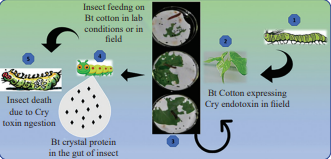
Pest Resistant Plants
The nematode Meloidogyne incognita infects tobacco plant roots, reducing yield significantly. This complementary RNA could come from viruses with RNA genomes or mobile genetic elements such as transposons. RNA interference (RNAi) is a novel strategy to fight this infestation.
RNAi, a cellular defense mechanism found in all eukaryotic organisms, involves silencing specific mRNA by binding complementary dsRNA molecules, inhibiting mRNA translation. Transposons are DNA units capable of moving between DNA molecules. Nematode-specific genes were introduced into the host plant using Agrobacterium vectors.
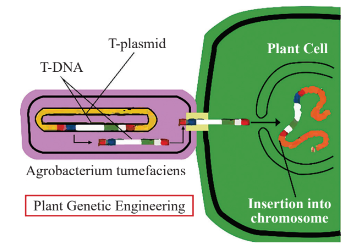
RNA Interference
DNA was introduced so the host cells produced sense and antisense RNA. These two RNAs being complementary to each other formed a double stranded RNA (dsRNA) that initiated RNAi and thus, silenced the specific mRNA of the nematode.
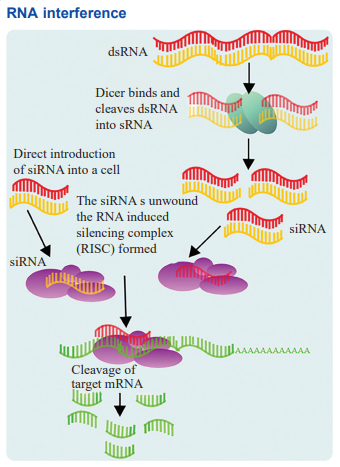
Biotechnological Applications in Medicine
Recombinant DNA technology has significantly impacted healthcare by allowing for the large scale production of safer and more effective therapeutic drugs. Recombinant therapeutics, unlike products derived from non-human sources, rarely cause adverse immunological reactions. Approximately 30 recombinant therapeutics have been authorized for human use globally, with 12 currently available in the Indian market.
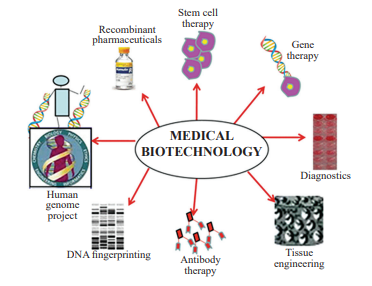
Genetically Engineered Insulin
Many individuals worldwide suffer from diabetes, necessitating treatment with medication or insulin. Initially, insulin was sourced from the pancreas of cattle and pigs, causing challenges such as limited availability and adverse side effects in some patients. To address these concerns, alternative methods for insulin production were explored, including recombinant DNA (rDNA) technology.
One of the main challenges faced in insulin production through rDNA technology was the complex structure of insulin, which consists of two chains linked by disulphide bridges. Human insulin comprises one chain of 21 amino acids (A chain) and another of 30 amino acids (B chain) connected by these bridges. In mammals, insulin is also synthesized as a pro-hormone containing an extra stretch called the C peptide. This C peptide is removed from the pro-hormone to form mature insulin.
In 1983, Eli Lilly, an American company, successfully prepared the DNA sequences for insulin chains A and B and inserted them into E. coli bacteria to produce the individual chains. These chains were then combined to form mature insulin by forming disulphide bonds. This breakthrough in biotechnology enabled mass production of insulin without animal sources, providing a safer and more sustainable solution for diabetes treatment.
Gene Therapy
Gene therapy involves correcting gene defects in embryos or children post-diagnosis. The first clinical application occurred in 1990 when a four-year-old with ADA deficiency received treatment. This genetic disorder results from a gene deletion causing adenosine deaminase deficiency. While some cases can be cured with bone marrow transplants, others require enzyme replacement therapy, where functional ADA enzymes are injected.
In gene therapy, normal ADA gene copies are cloned and packaged into defective retroviruses. These are introduced into lymphocytes isolated from patients, delivering functional ADA cDNA. Although this method is not permanent, as lymphocytes perish after a few days, it offers potential. A long-term solution may involve introducing genes into developing embryos for a lasting cure.
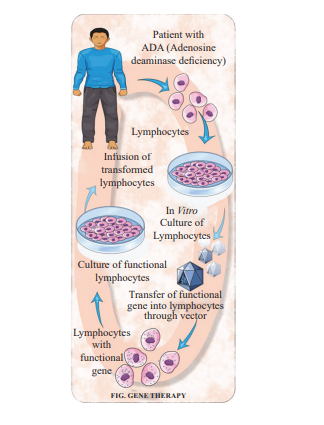
Molecular Diagnosis
Detecting pathogens in the body early is essential for easier and more effective treatment. However, traditional methods of analyzing serum, blood or urine make identifying infections in their early stages challenging. Early detection is facilitated by methods such as:
- Recombinant DNA technology
- Polymerase chain reaction (PCR)
- Enzyme-linked immunosorbent assay (ELISA).
Recombinant DNA Technology
Recombinant DNA technology combines DNA from different sources to create new genetic combinations, often used in biotechnology and genetic engineering.
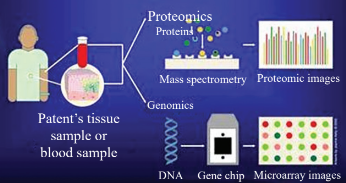
Polymerase Chain Reaction (PCR)
PCR is a technique used in molecular biology to amplify a single or a few copies of a piece of DNA, generating thousands to millions of copies of that particular DNA sequence.
[caption id="attachment_139255" align="aligncenter" width="500"]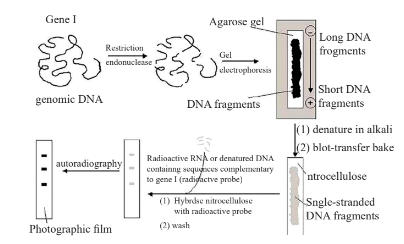 Polymerase Chain Reaction (PCR)[/caption]
Polymerase Chain Reaction (PCR)[/caption]
Enzyme Linked Immunosorbent Assay (ELISA)
ELISA is a powerful immunological technique used to detect the presence of specific proteins, antibodies, or antigens in a sample, often used in medical diagnostics and research.

Vaccine Production
Vaccines are manufactured using recombinant DNA technology through the following procedures:
- Antigen Generation: Antigens are produced from microbes. These can either be components of the disease-causing microorganism or proteins derived from it that are weakened or inactivated.
- Antigen Isolation: The antigens are separated from the culture in which they were generated.
- Addition of Preservatives and Adjuvants: Preservatives are included in the vaccine to enable multi-dose usage, while adjuvants enhance the immune response to the vaccine antigens. Stabilizers are also added to extend the vaccine's shelf life.
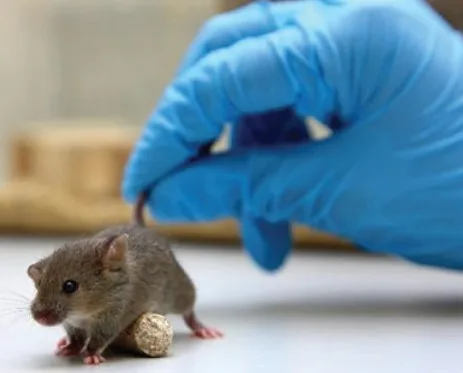
Transgenic Animals
Animals altered to incorporate foreign DNA are termed transgenic animals. Examples of genetically modified animals include rats, rabbits, pigs, sheep, cows, and fish. Transgenic animals express the characteristics of the introduced foreign gene.
The modification of animals is carried out to investigate various aspects:
Normal physiology and development: Transgenic animals aid in studying gene functions during normal growth and development.
They help analyze the impact of factors like insulin and growth factors on organismal growth.
Introduction of genes from other species enables the study of their effects in animals.
Study of diseases: Transgenic animals serve as valuable models for studying diseases and exploring potential treatments.
They are instrumental in researching conditions like cancer, cystic fibrosis, rheumatoid arthritis, and Alzheimer’s disease.
Biological products: Transgenic animals are engineered to produce beneficial biological products, such as human proteins like α-1-antitrypsin used for treating emphysema.
Notably, the first transgenic cow named Rosie produced human protein-enriched milk, offering a nutritionally balanced alternative for human infants.
Vaccine safety: Animals, including transgenic mice and monkeys are utilized to evaluate vaccine safety before human trials.
Transgenic mice, if proven safe, may replace monkeys in future vaccine safety assessments.
Chemical safety testing: Transgenic animals with enhanced sensitivity to toxic substances facilitate toxicity testing.
To study their effects efficiently, these animals are exposed to toxic substances, expediting safety evaluations.
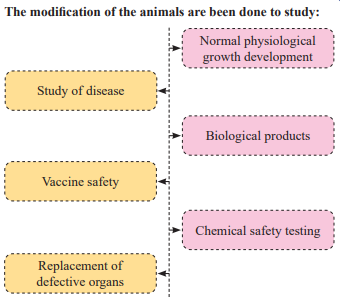
Steps to Produce Transgenic Animals
The following are the steps to produce transgenic animals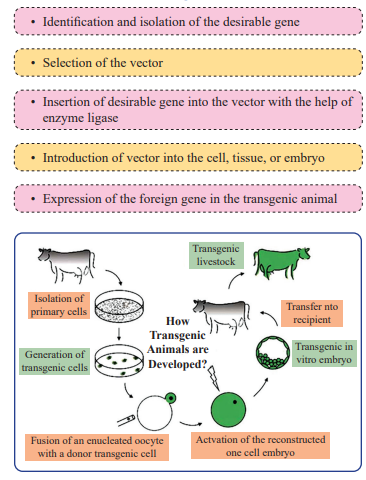
Ethical Issues
Human's manipulation of living organisms necessitates regulation to ensure ethical standards are upheld in activities that could impact these organisms positively or negatively. Genetic modification of organisms poses potential risks when introduced into ecosystems, highlighting the need for oversight.
In India, the Genetic Engineering Approval Committee (GEAC) evaluates the validity and safety of genetically modified organisms for public use. However, using genetically modified resources has raised patent issues, particularly concerning exploitation by multinational companies. Instances include patent disputes over resources like Neem, turmeric, and basmati rice.
For example, the US patent office granted a patent for turmeric's wound-healing properties, challenged by Dr. R.A. Mashelkar and subsequently revoked. Similarly, a patent for neem's oil fungicidal uses was challenged and revoked after objections by Vandana Shiva and Ajay Phadke. B asmati rice varieties faced a patent dispute when Texas patented Basmati rice grains, leading to a diplomatic crisis between India and the US before the patent was ultimately revoked, illustrating biopiracy concerns.
Biopiracy
Biopiracy refers to the unauthorized use of biological resources and traditional knowledge by multinational corporations and other entities, often without proper compensation or permission from the countries and communities that possess these resources. While industrialized nations may be financially affluent, they often lack rich bio-resources and traditional knowledge compared to developing countries, which are abundant in such resources.
This has led to instances where developed countries have exploited these resources without fair compensation or benefit-sharing agreements. In response, many nations are enacting laws to prevent such unauthorized exploitation and ensure equitable sharing of benefits. For instance, the Indian Parliament recently passed the second amendment to the Indian Patents Bill to address these issues and safeguard against exploitation.
Physics Wallah offers the best NEET Online Coaching and study materials for NEET candidates at an affordable price. Students planning to take the NEET Exam should enroll in the PW Online Courses for effective preparation. Enroll Now!
| NEET Exam Important Links | |
|---|---|
| NEET Biology Syllabus | NEET Biology Diagrams |
| NEET Biology MCQ | NEET Biology Chapter wise Weightage |
| NEET Biology Notes | NEET Previous Year Question papers |
Biotechnology And Its Applications FAQs
What is the definition of biotechnology?
What is the scope and application of biotechnology?
What are the four types of biotechnology?
Who is considered the father of biotechnology?
What is the significance of biotechnology?










